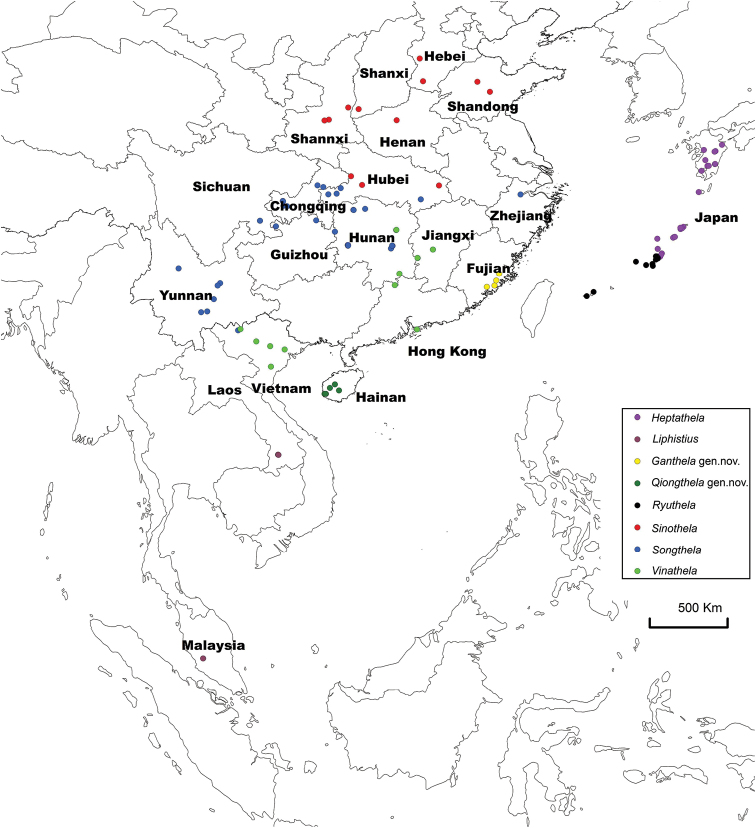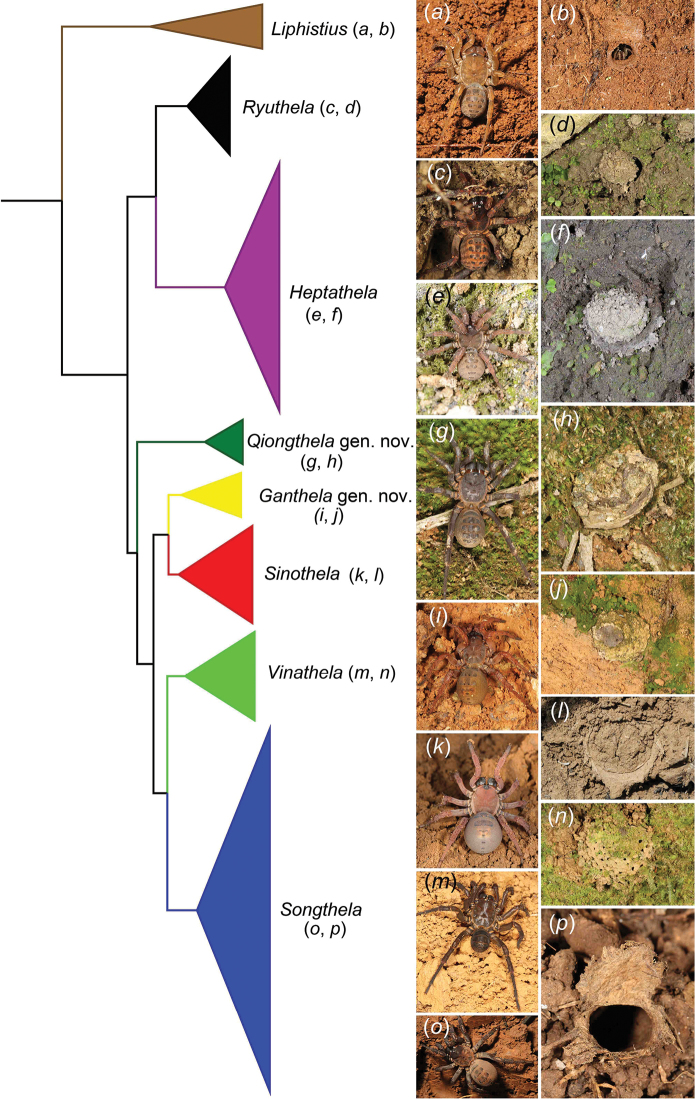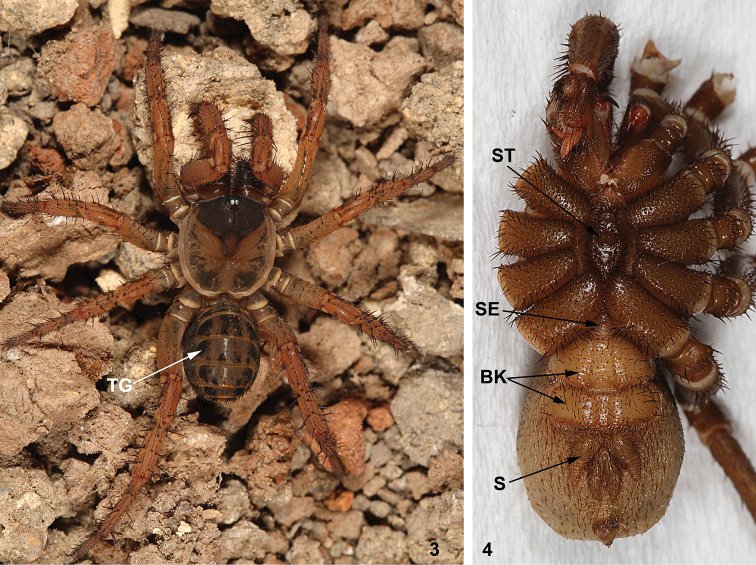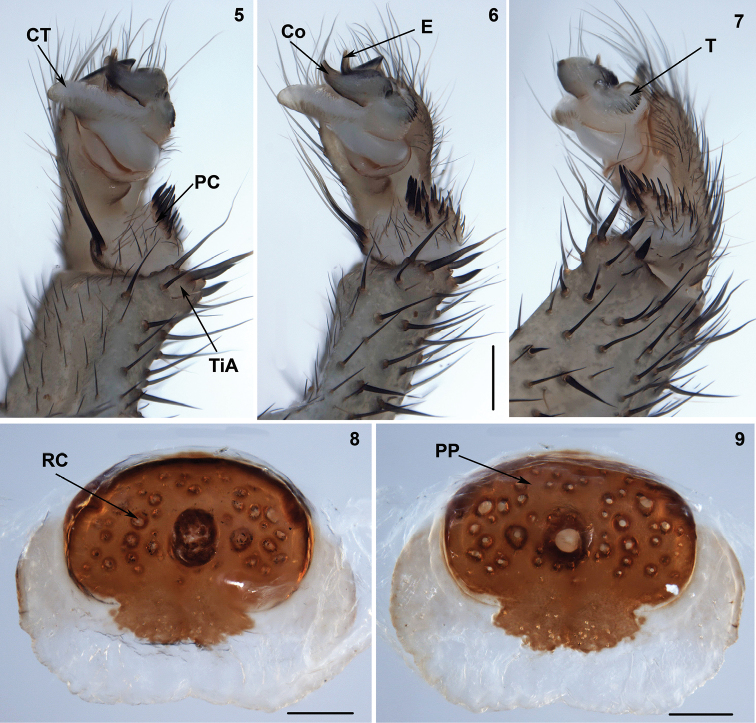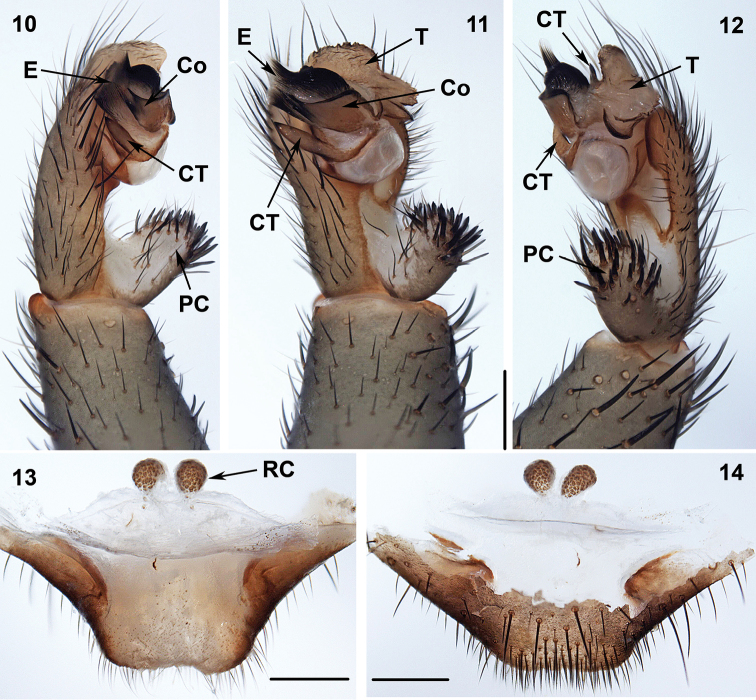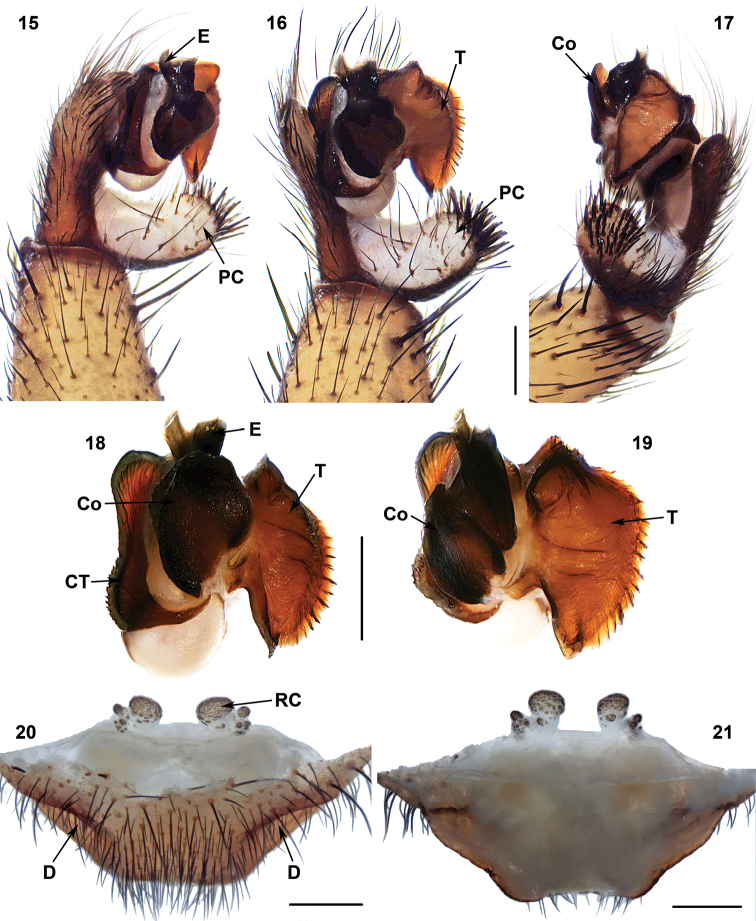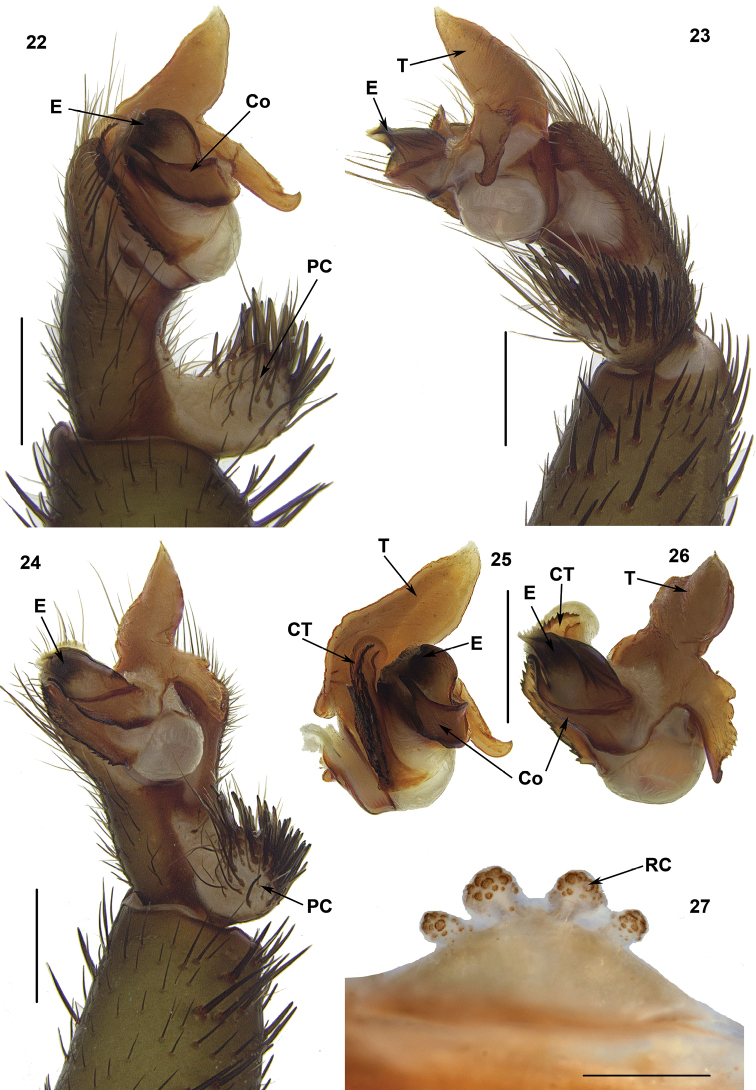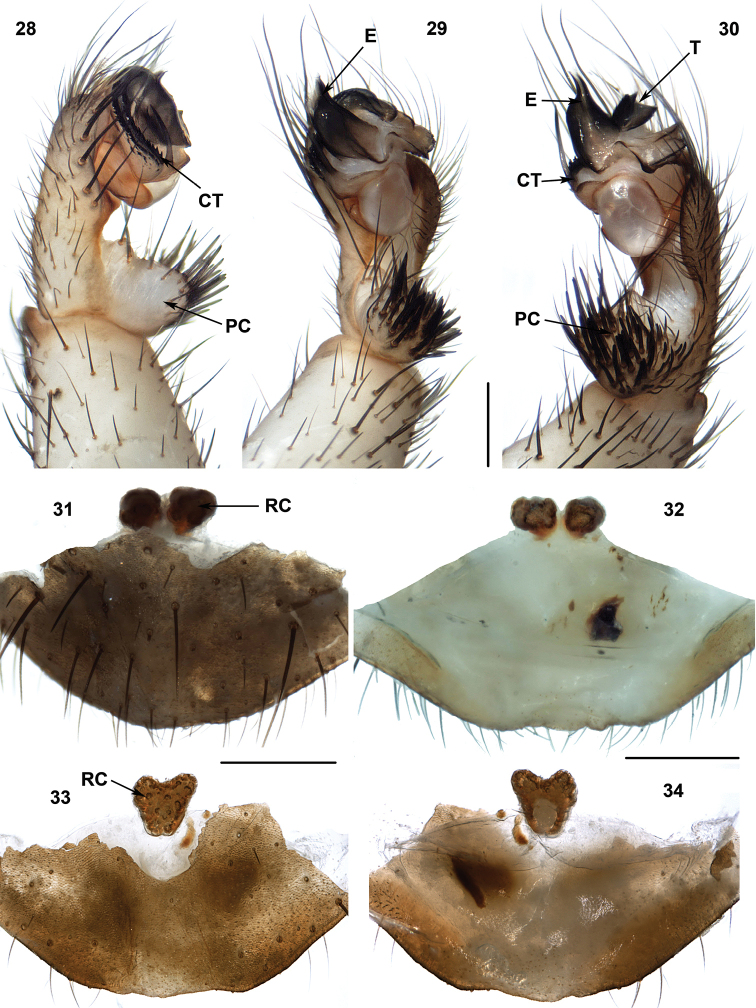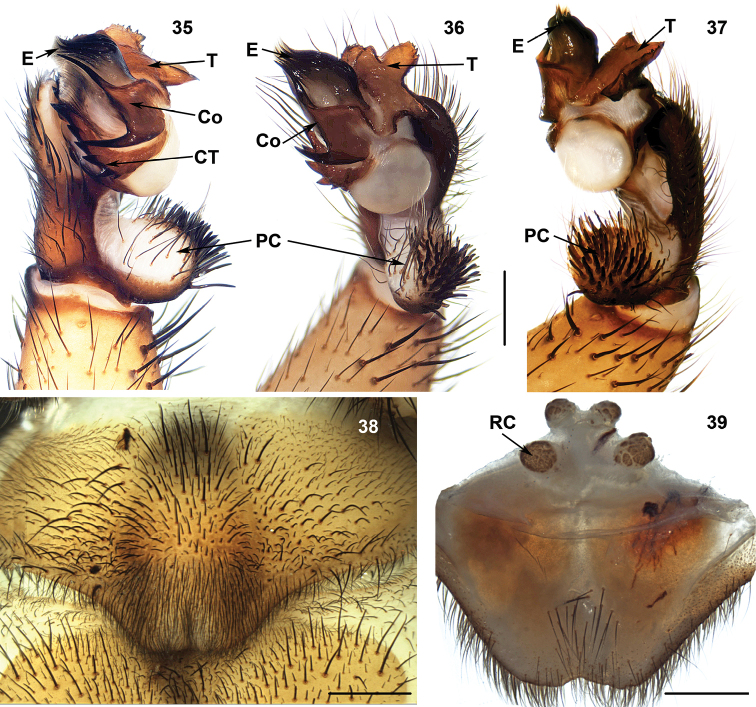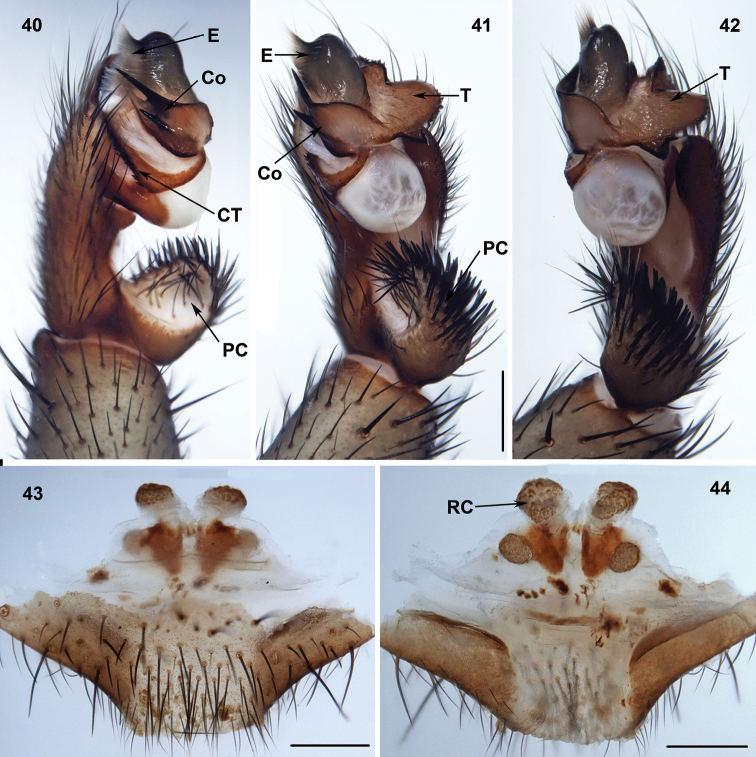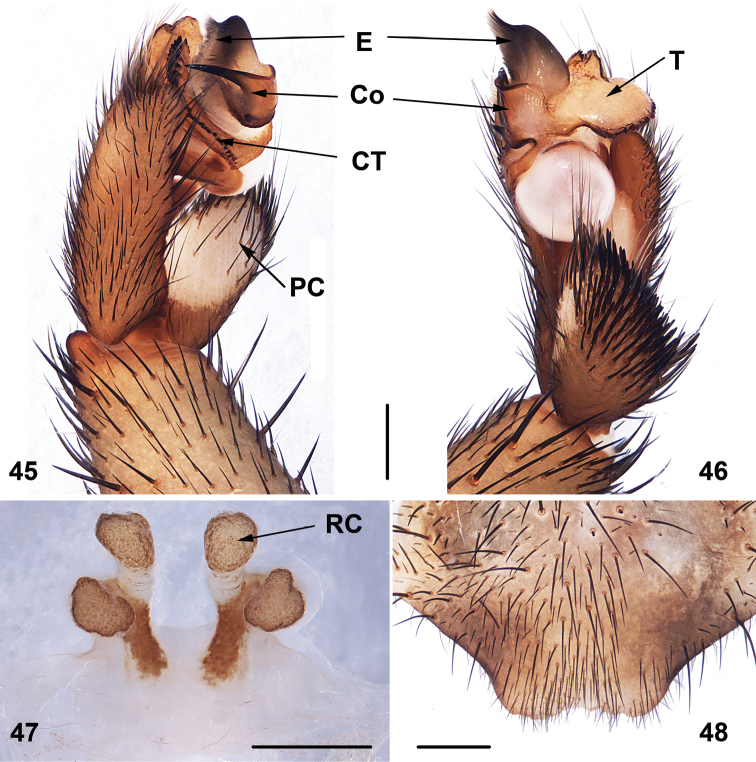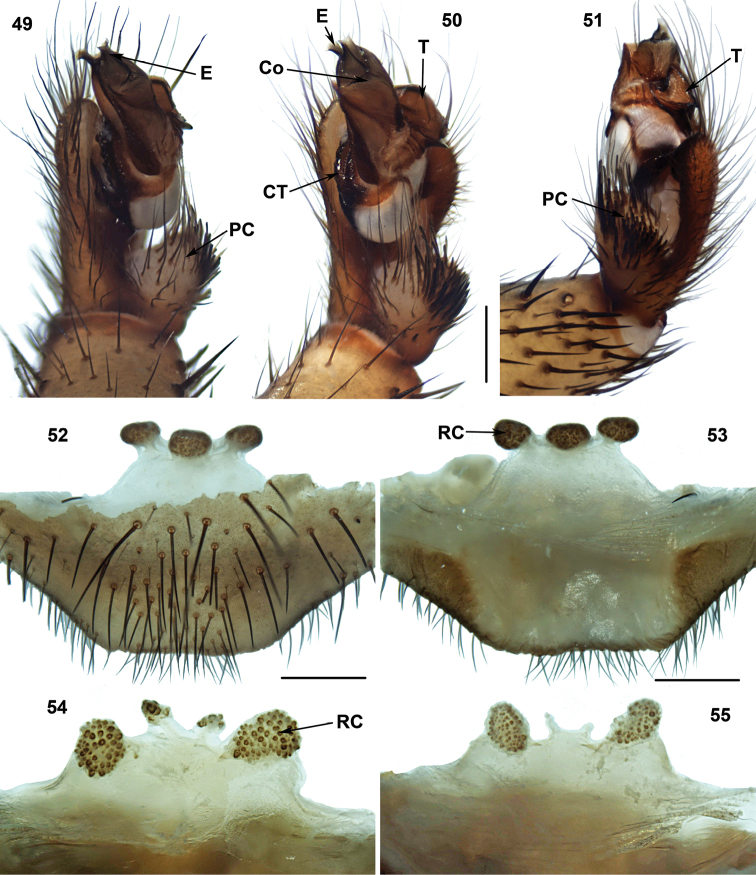Abstract Abstract
The spider suborder Mesothelae, containing a single extant family Liphistiidae, represents a species-poor and ancient lineage. These are conspicuous spiders that primitively retain a segmented abdomen and appendage-like spinnerets. While their classification history is nearly devoid of phylogenetic hypotheses, we here revise liphistiid genus level taxonomy based on original sampling throughout their Asian range, and on the evidence from a novel molecular phylogeny. By combining morphological and natural history evidence with phylogenetic relationships in the companion paper, we provide strong support for the monophyly of Liphistiidae, and the two subfamilies Liphistiinae and Heptathelinae. While the former only contains Liphistius Schiödte, 1849, a genus distributed in Indonesia (Sumatra), Laos, Malaysia, Myanmar, Thailand, we recognize and diagnose seven heptatheline genera, all but three removed from the synonymy of Heptathela: i) Ganthela Xu & Kuntner, gen. n. with the type species Ganthela yundingensis Xu, sp. n. is known from Fujian and Jiangxi, China; ii) a rediagnosed Heptathela Kishida, 1923 is confined to the Japanese islands (Kyushu and Okinawa); iii) Qiongthela Xu & Kuntner, gen. n. with the type species Qiongthela baishensis Xu, sp. n. is distributed disjunctly in Hainan, China and Vietnam; iv) Ryuthela Haupt, 1983 is confined to the Ryukyu archipelago (Japan); v) Sinothela Haupt, 2003 inhabits Chinese areas north of Yangtze; vi) Songthela Ono, 2000 inhabits southwest China and northern Vietnam; and vii) Vinathela Ono, 2000 (Abcathela Ono, 2000, syn. n.; Nanthela Haupt, 2003, syn. n.) is known from southeast China and Vietnam.
Keywords: East Asia, Southeast Asia, biogeography, classification, trapdoor spiders, living fossils
Introduction
The only extant family within the spider suborder Mesothelae, the family Liphistiidae consists of only 88 extant species-level taxa currently grouped in three genera, and displays an interesting geographical distribution confined to Southeast and East Asia (World Spider Catalog 2015). Liphistiids are relatively large, extremely long-lived (5–18 years), ground-dwelling spiders that build trapdoor burrows used for prey capture, shelter and protection (Bristowe 1976, Coddington and Levi 1991, Haupt 2003a). Despite being large and morphologically distinct, they are rarely encountered, making it difficult to secure taxonomically meaningful samples. Their natural history also suggests that liphistiids are confined to their burrows and that the spiders rarely move around, and phylogenetic and biogeographic analyses confirm that they are dispersal-limited and highly genetically structured (Xu et al. submitted).
Since their discovery (Schiödte 1849), much attention has been paid to taxonomy, and most authors (e.g. Schwendinger and Ono 2011) divide Liphistiidae into two distinct subfamilies, Liphistiinae Thorell, 1869 and Heptathelinae Kishida, 1923. Liphistiinae contains a single genus, Liphistius Schiödte, 1849 with 50 species-level taxa. Their genital morphology is quite distinct from the 38 currently known species of Heptathelinae, the latter including two currently valid genera, Heptathela Kishida, 1923 and Ryuthela Haupt, 1983 (World Spider Catalog 2015). Liphistiines are also geographically separated from heptathelines, since Liphistius occurs in Southeast Asia (Indonesia (Sumatra), Laos, Malaysia, Myanmar, Thailand), whereas the heptathelines Heptathela and Ryuthela are confined to East Asia (China, Japan and Vietnam), and Japanese Ryukyu Islands, respectively (World Spider Catalog 2015). Non-taxonomic studies of these spiders have focused on genital evolution (Osaki 1969, Kraus 1978, 1984, Haupt 1983, Yin et al. 1983, 1988, Yin 2001), life history (Yoshikura 1954, 1955, Haupt 1979, 1983, 1984, 1986, 1991, 2003a, Platnick and Sedgwick 1984, Schwendinger 1990), prey-capture (Haupt 1979, 1992, 2003a, Chen et al. 1981, Klingel 1967), mating behaviour (Murphy and Platnick 1981; Haupt 1977, 1979, 1983, 1984, 1992, 2003a, Haupt and Traue 1986, Schwendinger 1990), ecology (Murakami 1934, Klingel 1967, Bristowe 1976, Kikuya 1980, 1982, 1994, Schwendinger 1987, 1988, 1990, 1993, Schwendinger and Pape 2000, Haupt 2003a), zoogeography (Paik 1953, Ono 2000, Haupt 2003a, 2003b) and silk biology (Marples 1967, Haupt 1979, 1983, 1991, 1992, 2003a, Küchler 1987, Haupt and Kovoor 1993, Craig 1997, 2003, Vollrath and Selden 2007, Swanson et al. 2009, Strarrett et al. 2012).
All existing classification schemes for Mesothelae and Liphistiidae were dominated by a few selected characters and opinion rather than phylogenetic analyses. Schiödte (1849) described the first species of the genus Liphistius (Liphistius desultor) and Thorell (1869) placed it in Liphistioidae (sic). Simon (1903) nominated a new genus Anadiasthothela, but the species Anadiastothele thorelli was a synonym of Liphistius sumatranus Thorell, 1890 (see Bristowe 1932). Kishida (1923) erected a new genus Heptathela (based on Liphistius kimurai Kishida, 1920), and divided the family Liphistiidae into two subfamilies, Liphistiinae (including the tribes Liphistiiae and Heptatheleae) and Anadiasthothelinae (Anadiasthothele Simon, 1903) based on details on spinnerets. In 1939, Petrunkevitch raised Heptathela to the family rank (Heptathelidae) to include Japanese and Chinese species. This classification system was retained until Haupt (1983, 1990) proposed dividing the group into three genera and two families (Liphistiidae (Liphistius), Heptathelidae (Heptathela and Ryuthela)). Ono’s (2000) scheme treated the groups as two subfamilies: Liphistiinae and Heptathelinae. To Heptathela and Ryuthela, Ono (2000) added three new heptatheline genera, Abcathela, Songthela and Vinathela, solely based on the female genital morphology. However, Haupt (2003a) continued to prefer his two-family system (Haupt 1984, 1990), rejected Abcathela and Vinathela, considered Songthela as a synonym of Sinothela Haupt, 2003, and erected Nanthela Haupt, 2003. In the most recent classification scheme of the family, Schwendinger and Ono (2011) rejected all but three genera: Liphistius (Liphistiinae), Heptathela (Heptathelinae) and Ryuthela (Heptathelinae). However, they expressed some doubt at the validity of the genus Heptathela, with no fewer than 33 nominal taxa. According to these authors, Heptathela may need to be split again if a comprehensive revision and/or phylogeny was to suggest this.
A modern, species-level phylogeny of liphistiid spiders necessary for addressing taxonomic, evolutionary, and biogeographic questions has been long overdue. In a sister paper (Xu et al. submitted), we used molecular data from our original extensive sampling to test the monophyly of the family Liphistiidae and the genera within. Based on a species-level multi-locus phylogeny reported in that paper, and on morphological and natural history diagnostic characters provided here, we revise below the higher level systematics of the family.
Materials and methods
In order to secure a comparative sample of these seemingly rare spiders, we sampled liphistiids through China, Japan and Vietnam both at type locations and in areas with suitable habitat. We collected adults and immature spiders by excavating them from their subterranean burrows, then reared juveniles to adulthood in the laboratory. Since we primarily focused on heptathelines (the liphistiids of East Asia), our sample is biased toward China, Japan, and Vietnam (Figure 1).
Figure 1.
Map showing the sampling localities of liphistiid spider specimens across Southeast and East Asia.
Specimens were studied using an Olympus SZX16 stereomicroscope, and anatomical details were examined and photographed with Leica M205C stereomicroscope and Olympus BX51 compound microscope. Genitalia were cleared in boiling KOH for a few minutes to dissolve soft tissues. Unless otherwise noted left palps were depicted. All measurements are in millimeters. Leg and palp measurements are given in the following order: total length (femur + patella + tibia + metatarsus + tarsus).
Abbreviations used are: ALE, AME, BK, BL, CL, Co, CT, CW, D, E, OL, OW, PC, PLE, PME, PP, RC, S, SE, ST, T, TG, TiA.
Results
In three years we accumulated 1,455 specimens (786 females, 118 males and 551 juveniles) from 145 localities in China, Japan, Laos, Malaysia and Vietnam. These vouchers, deposited at the Centre for Behavioural Ecology and Evolution (CBEE), College of Life Sciences, Hubei University, Wuhan, China, were the basis for our morphological examinations (reported here) and for molecular analyses (Xu et al. submitted). Examined and illustrated specimens were labelled with unique codes (Appendix 1; see also Figure legends), which will be reused in the upcoming genus-level revisions. All designated type specimens were deposited at the National Zoological Museum of China (NZMC), Institute of Zoology, Chinese Academy of Sciences, Beijing, China.
Our trips to chosen sampling points based on the known records were highly successful, and we found heptathelines at most type localities except for Ryuthela iheyana from Ihayajima, Japan, Sinothela sinensis (Bishop & Crosby, 1932), comb. n. from the type locality, Jinan City, Shandong Province, Sinothela schensiensis (Schenkel, 1953), comb. n. from Tongyuan County, Shannxi Province, Songthela hunanensis (Song & Haupt, 1984), comb. n. from Qianyang County, Hunan Province, Songthela yunnanensis (Song & Haupt, 1984), comb. n. from Kunming, Yunnan Province. We did not sample Qiongthela nui (Schwendinger & Ono, 2011), comb. n. and Qiongthela australis (Ono, 2002), comb. n. from Lam Dong Province. Most of the field expeditions into previously unsampled areas in China were also successful. New liphistiid localities include Chongqing, Fujian (Putian, Quanzhou and Xiamen), Guizhou (Chishui and Yanhe), Hainan, Hebei (Yongnian), Hubei (Badong, Enshi, Jianshi, Lichuan and Yichang), Jiangxi (Ji’an), Yunan (Dali, Kunming, Mojiang and Yuanjian), and Shandong (Zhangqiu and Yiyuan) Provinces.
In a concurrent paper (Xu et al. submitted), we report on phylogenetic analyses using original five-gene nucleotide data for 75 species. These results, summarized in Figure 2, form the phylogenetic basis for a revised classification of the family. The family and subfamily monophyly were well supported in all phylogenetic analyses (for details, see Xu et al. submitted). The current classification of Liphistiidae, based on morphological features, treats as valid three genera (see World Spider Catalog 2015): Heptathela s.l., Liphistius and Ryuthela. Our phylogenetic results strongly support the monophyly of Liphistius and Ryuthela, but not of Heptathela s.l., and thus require substantial taxonomic emendations. Below, we classify the species currently in paraphyletic Heptathela s.l. in six genera—the monophyly of each strongly supported (for details, see Xu et al. submitted)—of which two are new, describe two new species that become the type for the new genera, and propose further synonymies.
Figure 2.
A simplified genus level phylogeny derived from the summary tree in the accompanying paper (Xu et al. submitted), as the basis for newly proposed classification. Images on the right depict typical generic characteristics (female habitus and trapdoor).
Taxonomy
Suborder. Mesothelae
Pocock, 1892
Phylogenetic definition
(for details, see Xu et al. submitted). In the analysis of divergence times, we treated Mesothelae as a stem group leading from the root of all spiders to the node-based clade Liphistiidae. Therefore, Mesothelae accommodates the fossil genus Palaeothele Selden, 2000, which does not share one of the synapomorphies of Liphistiidae (single row of teeth on cheliceral fang groove). Although the morphological diagnosis resembles that of Liphistiidae, Mesothelae is inclusive of Liphistiidae but the two groups are phylogenetically not identical.
Composition.
Mesothelae includes the crown group Liphistiidae with extant species from East and Southeast Asia, and the fossil Palaeothele montceauensis (Selden 1996a, b) from the Upper Carboniferous of Montceau-les-Mines, France around 295 Ma.
Family. Liphistiidae
Thorell, 1869
Diagnosis.
Unlike all other extant spiders, Liphistiidae possess tergites on all abdominal segments (Figure 3), their spinnerets are located in the middle of abdominal venter (Figure 4), and in addition to a narrow sternum they also possess another narrow ventral plate, the sternite, located adjacent to coxae IV (Figure 4).
Figures 3–4.
General somatic morphology of Liphistiidae. 3 Female Heptathela yanbaruensis Haupt, 1983 (XUX-2014–038A) 4 Male Qiongthela baishensis sp. n. (XUX-2012–087). BK = book lung, S = spinneret, SE = sternite, ST = sternum, TG = tergite.
Description.
Medium to large sized ground dwelling and burrowing spiders, chelicerae with a single row of teeth, two pairs of book lungs (Figure 4), tibial spurs specialized as sense organs. Their ground burrows are closed with trapdoors, with or without additional concentric signal lines (Figure 2b, d, f, h, j, l, n, p).
Composition. Ganthela Xu & Kuntner, gen. n., Heptathela Kishida, 1923, Liphistius Schiödte, 1849, Qiongthela Xu & Kuntner, gen. n., Ryuthela Haupt, 1983, Sinothela Haupt, 2003a, Songthela Ono, 2000, and Vinathela Ono, 2000.
Distribution.
China, Indonesia (Sumatra), Japan, Laos, Malaysia, Myanmar, Thailand and Vietnam.
Subfamily. Liphistiinae
Thorell, 1869
Diagnosis.
In contrast to the members of the subfamily Heptathelinae, Liphistiinae spiders construct signal lines radiating from the burrow entrance (Figure 2b), the male palp possesses a tibial apophysis (Figures 5–7), and the female genitals have a poreplate and unpaired receptacular clusters (Figures 8–9). Platnick and Sedgwick (1984) also report the unique presence of clavate trichobothria on the tarsi and metatarsi of all legs and on the palpal tarsi.
Figures 5–9.
Male (XUX-2013–267) and female (XUX-2013–256) genital anatomy of Liphistius laoticus Schwendinger, 2013. 5 palp prolateral view 6 palp ventral view 7 palp retrolateral view 8 vulva ventral view 9 vulva dorsal view. Scales 3–5: 0.5 mm, 6–7: 0.1 mm. Co = conductor, CT = contrategulum, E = embolus, PC = paracymbium, PP = poreplate, RC = receptacular cluster, T = tegulum, TiA = tibial apophysis.
Composition.
Liphistius Schiödte, 1849.
Distribution.
Indonesia (Sumatra), Laos, Malaysia, Myanmar, Thailand.
Genus. Liphistius
Schiödte, 1849
Liphistius Schiödte, 1849, type species Liphistius desultor Schiödte, 1849, P. 621.
Anadiastothele Simon, 1903, type species by original designation Anadiastothele thorelli Simon, 1903 = Liphistius sumatranus Thorell, 1890, P. 875; first synonymised by Bristowe, 1932, P. 1022.
Diagnosis.
See Liphistiinae.
Description.
Total length (excluding chelicerae) = 9–37 mm (Platnick and Sedgwick 1984); male palp with retrolateral tibial apophysis bearing strong apical spines and with a spinose paracymbium; female genitalia with a poreplate and unpaired receptacular clusters.
Species composition.
Liphistius albipes Schwendinger, 1995; Liphistius batuensis Abraham, 1923; Liphistius bicoloripes Ono, 1988; Liphistius birmanicus Thorell, 1897; Liphistius bristowei Platnick & Sedgwick, 1984; Liphistius castaneus Schwendinger, 1995; Liphistius dangrek Schwendinger, 1996; Liphistius desultor Schiödte, 1849; Liphistius endau Sedgwick & Platnick, 1987; Liphistius erawan Schwendinger, 1996; Liphistius fuscus Schwendinger, 1995; Liphistius isan Schwendinger, 1998; Liphistius jarujini Ono, 1988; Liphistius johore Platnick & Sedgwick, 1984; Liphistius kanthan Platnick, 1997; Liphistius lahu Schwendinger, 1998; Liphistius langkawi Platnick & Sedgwick, 1984; Liphistius lannaianus Schwendinger, 1990; Liphistius laoticus Schwendinger, 2013; Liphistius laruticus Schwendinger, 1997; Liphistius lordae Platnick & Sedgwick, 1984; Liphistius malayanus Abraham, 1923; Liphistius malayanus cameroni Haupt, 1983; Liphistius marginatus Schwendinger, 1990; Liphistius murphyorum Platnick & Sedgwick, 1984; Liphistius nesioticus Schwendinger, 1996; Liphistius niphanae Ono, 1988; Liphistius ochraceus Ono & Schwendinger, 1990; Liphistius onoi Schwendinger, 1996; Liphistius ornatus Ono & Schwendinger, 1990; Liphistius owadai Ono & Schwendinger, 1990; Liphistius panching Platnick & Sedgwick, 1984; Liphistius phileion Schwendinger, 1998; Liphistius phuketensis Schwendinger, 1998; Liphistius pusohm Schwendinger, 1996; Liphistius rufipes Schwendinger, 1995; Liphistius sayam Schwendinger, 1998; Liphistius schwendingeri Ono, 1988; Liphistius sumatranus Thorell, 1890; Liphistius suwat Schwendinger, 1996; Liphistius tempurung Platnick, 1997; Liphistius tenuis Schwendinger, 1996; Liphistius thaleban Schwendinger, 1990; Liphistius thaleri Schwendinger, 2009; Liphistius tham Sedgwick & Schwendinger, 1990; Liphistius thoranie Schwendinger, 1996; Liphistius tioman Platnick & Sedgwick, 1984; Liphistius trang Platnick & Sedgwick, 1984; Liphistius yamasakii Ono, 1988; Liphistius yangae Platnick & Sedgwick, 1984.
Distribution.
Indonesia (Sumatra), Laos, Malaysia, Myanmar, Thailand.
Remarks.
Liphistius always possess eight spinnerets, unlike all the remaining liphistiid genera in which the number is variable (either seven or eight). Therefore, the number of spinnerets is not a criterion for discriminating genera and species (Haupt 1983).
Subfamily. Heptathelinae
Kishida, 1923
Diagnosis.
In contrast to the members of the subfamily Liphistiinae, the representatives of Heptathelinae lack signal lines radiating from the burrow entrance (Figure 2d, f, h, j, l, n, p), the male palp lacks a tibial apophysis (Figures 10–12, 15–17, 20–22, 26–28, 31–33, 36–38, 41–43), and the female genitals have paired or unpaired receptacular clusters on the bursa copulatrix with or without stalks (Figures 13–14, 18–19, 25, 34–35, 39–40, 44–45).
Figures 10–14.
Male (XUX-2013–136) and female (XUX-2013–135) genital anatomy of Ganthela yundingensis sp. n. 10 palp prolateral view 11 palp ventral view 12 palp retrolateral view 13 vulva dorsal view 14 vulva ventral view. Scales 0.5 mm. RC = receptacular cluster.
Figures 15–21.
Male (XUX-2013–389) and female (XUX-2013–351) genital anatomy of Heptathela higoensis Haupt, 1983 and Heptathela kimurai (Kishida, 1920), respectively. 15 palp prolateral view 16 palp ventral view 17 palp retrolateral view 18 contrategulum, conductor and embolus, ventral view 19 contrategulum, conductor and embolus, retrolateral view 20 vulva ventral view 21 vulva dorsal view; Scales 0.5 mm. D = depression.
Figures 22–27.
Male (XUX-2012–087) and female (XUX-2012–086) genital anatomy of Qiongthela baishensis sp. n. 22 palp prolateral view 23 palp retrolateral view 24 palp ventral view 25–26 contrategulum, conductor and embolus, distal view 27 vulva dorsal view. Scales 18–20: 1 mm, 21–23: 0.5 mm.
Figures 28–34.
Male (XUX-2013–228) and female (31–32 XUX-2012–302 and 33–34 XUX-2012–364) genital anatomy of Ryuthela ishigakiensis Haupt, 1983, Ryuthela nishihirai (Haupt, 1979), and Ryuthela sasakii Ono, 1997, respectively. 28 palp prolateral view 29 palp ventral view 30 palp retrolateral view 31, 33 vulva ventral view 32, 34 vulva dorsal view. Scales 0.5 mm.
Figures 35–39.
Male (XUX-2012–045) and female (XUX-2012–035) genital anatomy of Sinothela sinensis (Bishop & Crosby, 1932), comb. n. 35 palp prolateral view 36 palp ventral view 37 palp retrolateral view 38 vulva ventral view 39 vulva dorsal view. Scales 0.5 mm.
Figures 40–44.
Male (XUX-2013–175) and female (XUX-2013–170) genital anatomy of Songthela hangzhouensis (Chen, Zhang & Zhu, 1981), comb. n. 40 palp prolateral view 41 palp ventral view 42 palp retrolateral view 43 vulva ventral view 44 vulva dorsal view. Scales 0.5 mm.
Figures 45–48.
Male (XUX-2011–078) and female (XUX-2011–043) genital anatomy of Songthela goulouensis (Yin, 2001), comb. n. 45 palp prolateral view 46 palp retrolateral view 47 vulva ventral view 48 vulva dorsal view. Scales 0.5 mm.
Composition.
Ganthela Xu & Kuntner, gen. n., Heptathela Kishida, 1923, Qiongthela Xu & Kuntner, gen. n., Ryuthela Haupt, 1983, Sinothela Haupt, 2003a, Songthela Ono, 2000, and Vinathela Ono, 2000.
Distribution.
China, Japan and Vietnam.
Genus. Ganthela
Xu & Kuntner gen. n.
http://zoobank.org/F70E24D5-C13B-4195-825C-A69A684AB893
Liphistius : Wang 1989, P. 30, description of Liphistius cipingensis (= Ganthela cipingensis).
Songthela : Ono 2000, P. 150, transferred Liphistius cipingensis to Songthela cipingensis (= Ganthela cipingensis).
Heptathela : Platnick 1993, P. 77, transferred Liphistius cipingensis to Heptathela cipingensis (= Ganthela cipengensis).
Type species.
Ganthela yundingensis sp. n.
Etymology.
The genera of heptathelines contain in their name the word ‘thela’ referring to spinnerets as the Greek word thele means nipple-like protuberance (Ono 2000). We continue this tradition, but name the genus to start with Gan-, which refers to Jiangxi Province.
Diagnosis.
Males of Ganthela differs from all other Heptathelinae genera by a smooth conductor with a distal spiniform apex (Figures 10–11), a flat opening embolus and scale-like contrategulum (Figures 10–11), females can be identified by a single pair of similar receptacular clusters (Figures 13–14).
Description.
Total length (excluding chelicerae) = 8–15 mm (N = 35); male palpal conductor smooth, wide, leaf-shaped, with a spiniform apex (Figures 10–11); spinose paracymbium relative short (Figures 10, 12); embolus with a flat opening (Figures 10–11); contrategulum scale-like with a smooth margin (Figures 10–11); female genitalia with paired receptacular clusters of similar size, situated at the anterior margin of the bursa copulatrix with tubular stems (Figures 13–14).
Species composition.
Ganthela cipingensis (Wang, 1989), comb. n. (7♀), male is unknown, Ganthela yundingensis Xu, sp. n. (1♂1♀), one undescribed species from Jiangxi Province, China (11♀), and four undescribed species from Fujian Province, China (1♀, 1♂11♀, 1♀, and 3♀, respectively).
Distribution.
China (Fujian, Jiangxi).
Remarks.
Wang (1989) placed Ganthela cipingensis in Liphistius based on the presence of eight spinnerets. Our collections from the type locality contain specimens with seven spinnerets. The number of spinnerets thus varies intraspecifically.
Ganthela yundingensis
Xu sp. n.
http://zoobank.org/4F54A057-613A-4E8E-ADB4-B1B0AA0BB579
Types.
Male holotype (XUX-2013–136) and female paratype from Mt. Yunding, Tingxi Town, Tong’an District, Xiamen City, Fujian Province, China; 24.87°N, 118.16°E, 631 m; 8 July 2013; collected by F. Liu, X. Xu and Z. Zhang, deposited at NZMC, Institute of Zoology, Chinese Academy of Sciences, Beijing, China.
Etymology.
‘Yunding’ refers to the type locality of this species, Mt. Yunding.
Diagnosis.
Females can be distinguished from Ganthela cipingensis and the five undescribed Ganthela species we are aware of by lacking genital stalks (Figures 13–14), and the males, uniquely among heptathelines, possess the contrategulum with two marginal apophyses (Figures 11–12), the prolateral one being scale-like (Figure 11).
Description.
Male (holotype). Carapace and opisthosoma light brown; tergites dark brown; sternum narrow, twice as long as wide; a few long pointed hairs running over ocular mound in a longitudinal row; chelicerae robust with promargin of cheliceral groove with 10 denticles of variable size; legs with strong hairs and spines; opisthosoma with 12 tergites, the first 2–5 larger than others and the fourth largest, the first four close to each other; 7 spinnerets. Measurements: BL 9.80, CL 4.48, CW 4.03, OL 4.98, OW 3.75; ALE > PLE > PME > AME; leg I 13.60 (4.03 + 1.48 + 2.90 + 3.41 + 1.78), leg II 13.80 (3.81 + 1.70 + 2.91 + 3.48 + 1.90), leg III 16.01 (4.02 + 1.71 + 3.28 + 4.58 + 2.42), leg IV 20.60 (5.20 + 1.89 + 3.90 + 6.50 + 3.11).
Palp: Cymbium with a projection; prolateral side of paracymbium unpigmented and unsclerotised, numerous setae and spines at the tip of paracymbium (Figures 10–12). Contrategulum has two marginal apophyses, the first one scale-like with a smooth margin (Figures 10–11). Tegulum with a dentate edge (Figures 11–12). Conductor wide leaf-shaped, with spiniform apex, parallel to embolus (Figures 10–11). Embolus largely sclerotized, with a flat opening (Figures 10–11).
Female. Colouration of carapace and opisthosoma as in male; chelicerae robust with promargin of cheliceral groove with 12 strong denticles of variable size; legs with strong hairs and spines; opisthosoma with 12 tergites, as in male; 7 spinnerets. Measurements: BL 13.23, CL 5.96, CW 5.18, OL 7.28, OW 4.90; ALE > PLE > PME > AME; palp 9.64 (3.26 + 1.61 + 2.15 + 2.62), leg I 11.46 (3.33 + 2.08 + 2.17 + 2.30 + 1.58), leg II 11.82 (3.56 + 2.11 + 2.13 + 2.42 + 1.60), leg III 13.18 (3.71 + 2.20 + 2.33 + 3.02 + 1.92), leg IV 17.59 (4.03 + 2.40 + 3.30 + 5.19 + 2.67).
Female genitalia: The posterior part of the genital area rectangular (Figure 13–14), a pair of receptacular clusters close to each other, without stalks (Figures 13–14).
Genus. Heptathela
Kishida, 1923
Heptathela Kishida, 1923, type species Liphistius kimurai Kishida, 1920, P. 235.
Diagnosis.
Heptathela males differ from all other Heptathelinae genera by a leaf-shaped conductor (Figures 18–19), a thumb-shaped embolus (Figures 15, 18) and a wide tegulum with a rugate margin (Figures 16, 18–19). Heptathela females can be distinguished from all other Heptathelinae genera by a single paired depression on the ventro-lateral part of genital atrium (Figure 20), and by the one pair of main receptacular cluster and secondary, lateral, irregular receptacular clusters (Figures 20–21).
Description.
Total length (excluding chelicerae) = 7–17 mm (N = 229); male palp with a leaf-shaped conductor with spiniform apex or dentate edge, rugate (Figures 18–19); spinose paracymbium long, nearly the length of the cymbium (Figures 15–16); embolus thumb-shape (Figures 15, 18); tegulum wide, with a rugate margin (Figures 16, 18–19); female genitalia with a paired depression on the ventro-lateral part of the genital atrium (Figure 20); with a pair of main receptacular cluster at the anterior margin of the bursa copulatrix and separated from each other, and with secondary, lateral, irregular receptacular clusters (Figures 20–21).
Species composition.
Heptathela amamiensis Haupt, 1983; Heptathela higoensis Haupt, 1983; Heptathela kanenoi Ono, 1996; Heptathela kikuyai Ono, 1998; Heptathela kimurai (Kishida, 1920); Heptathela nishikawai Ono, 1998; Heptathela yaginumai Ono, 1998; Heptathela yakushimaensis Ono, 1998; Heptathela yanbaruensis Haupt, 1983.
Distribution.
Japan (Kyushu and Okinawa).
Genus. Qiongthela
Xu & Kuntner gen. n.
http://zoobank.org/BA103085-F5FB-4DF1-81C7-CA5CDE26E65E
Type species.
Qiongthela baishensis sp. n.
Etymology.
The genera of heptathelines contain in their name the word ‘thela’ referring to spinnerets as the Greek word thele means nipple-like protuberance (Ono 2000). We continue this tradition, but name the genus to start with Qiong-, referring to Hainan Province, China.
Diagnosis.
Qiongthela males differ from all other Heptathelinae genera by the conductor with a narrow, blade-like, slightly hooked apex (Figures 22, 25–26), and by tegulum with two apophyses (Figures 23, 25–26). Qiongthela females can be distinguished from all other Heptathelinae by two paired receptacular clusters located at the anterior margin of the bursa copulatrix (Figure 27).
Description.
Total length (excluding chelicerae) = 13–31 mm (N = 14); male palp with a distally free conductor, narrow, blade-like with slightly hook-like apex, (Figures 22, 25–26); tegulum with two margins, spinose paracymbium (Figures 23, 25–26); female genitalia with two paired receptacular clusters, all situated at the anterior margin of the bursa copulatrix with more or less distinct tubular stems (Figure 27).
Species composition.
Qiongthela australis (Ono, 2002), comb. n., Qiongthela nui (Schwendinger & Ono, 2011), comb. n., Qiongthela baishensis sp. n. (3♂2♀), and three undescribed species (6♂8♀, 1♀ and 1♂1♀, respectively) from Hainan, China.
Distribution.
Hainan (China) and Vietnam.
Remarks.
Based on morphological descriptions, but not on phylogenetic analyses, we include two species from Vietnam in this genus, originally described as Songthela australis Ono, 2002 and Heptathela nui Schwendinger & Ono, 2011.
Qiongthela baishensis
Xu sp. n.
http://zoobank.org/5C0F3DB2-3A07-4FC6-83B5-3E286F1493F1
Types.
Male holotype (XUX-2012–087, matured 10 October 2012 at CBEE, College of Life Sciences, Hubei University) and two male and two female paratypes from Nangaoling Forest Plantation, Baisha County, Hainan Province, China; 19.24°N, 109.38°E, 463 m, collected 18 July 2012 by D. Li, F. Liu and X. Xu, deposited at NZMC, Institute of Zoology, Chinese Academy of Sciences, Beijing, China.
Etymology.
The species epithet refers to Baisha, the species type locality.
Diagnosis.
Unlike other Qiongthela species, males of Qiongthela baishensis possess three parallel serrated distal edges of the contrategulum (Figures 25, 26), and females have two pairs of receptacular clusters, the median pair larger than the lateral one, with very short or no stalks (Figure 27).
Description.
Male (holotype). Carapace and opisthosoma light brown; tergites darker; with a clear fovea; sternum narrow, nearly twice as long as wide; a few long pointed hairs running over ocular mound in a longitudinal row; chelicerae robust with promargin of cheliceral groove containing 10 denticles of variable size; legs with strong hairs and spines; opisthosoma with 12 tergites, the first 2–7 distinctly larger and the fifth largest; 7 spinnerets. Measurements: BL 16.75, CL 6.70, CW 6.65, OL 9.90, OW 7.45; ALE > PLE > PME > AME; leg I 19.76 (6.15 + 2.55 + 4.35 + 4.35 + 2.36), leg II 20.70 (5.59 + 2.67 + 4.24 + 5.45 + 2.75), leg III 21.16 (5.25 + 2.13 + 4.12 + 6.45 + 3.21), leg IV 26.03 (7.38 + 2.75 + 5.78 + 7.05 + 3.07).
Palp: Cymbium with a projection; prolateral side of paracymbium unpigmented and unsclerotised, numerous setae and spines at the tip of paracymbium (Figures 22, 24). Contrategulum with three parallel distal edges, row of denticles on inner edge running down to ventro-proximal margin of contrategulum and the outer row forming a sharp edge without denticles (Figures 22, 25–26). Tegulum with a very long, wide base, pointed, distally directed marginal apophysis with a sharp edge, and retrolaterally with a proximally directed terminal apophysis with a slightly short dentate row and continuously narrowing to a rounded, hooked apex (Figures 22–26). Conductor situated ventro-proximally on embolus, with a bent apex (Figures 22, 25–26). Embolus largely sclerotised, prolaterally with numerous longitudinal ribs (Figures 22–26).
Female (paratype). Colouration as in male; promargin of robust chelicerae with 9 strong denticles variable in size; legs and opisthosoma as in the male; 7 spinnerets. Measurements: BL 13.30–14.15, CL 4.51–6.23, CW 4.63–5.82, OL 7.20–7.45, OW 4.33–5.08; ALE > PLE > PME > AME; palp 10.25 (3.65 + 1.55 + 2.30 + 2.75), leg I 12.48 (4.25 + 1.95 + 2.53 + 2.55 + 1.20), leg II 12.15 (3.75 + 2.07 + 2.25 + 2.65 + 1.43), leg III 12.42 (3.55 + 2.12 + 2.03 + 3.07 + 1.65), leg IV 19.20 (5.45 + 2.65 + 3.45 + 5.10 + 2.55).
Female genitalia: Two pairs of receptacular clusters along the anterior margin of bursa copulatrix, the median pair larger than the lateral one, with very short or no stalks (Figure 27).
Genus. Ryuthela
Haupt, 1983
Ryuthela Haupt, 1983, type species Heptathela nishihirai Haupt, 1979, P. 286.
Diagnosis.
Ryuthela males differ from all other Heptathelinae genera by lacking the conductor and by the contrategulum with an enlongate spine (Figures 28, 30). The females differ from Heptathela, Qiongthela, Sinothela, Songthela and Vinathela by one paired receptacular cluster close to each other (Figures 31–32), located at the anterior margin of the bursa copulatrix, and from Ganthela by receptacular clusters without stems that may or may not be fused (Figures 31–34).
Description.
Total length (excluding chelicerae) = 7–15 mm (N = 151); male palp with denticulate contrategulum and ventral portion with an elongate spine (Figures 28, 30); spinose paracymbium relatively short (Figures 28–30); female genitalia usually with one paired receptacular clusters, except in some specimens, notably in Ryuthela sasakii, where receptacular clusters are unpaired and without stalks (Figures 31–34).
Species composition.
Ryuthela iheyana Ono, 2002; Ryuthela ishigakiensis Haupt, 1983; Ryuthela nishihirai (Haupt, 1979); Ryuthela sasakii Ono, 1997; Ryuthela tanikawai Ono, 1997.
Distribution.
Ryukyu Island (Japan).
Remarks.
In Ryuthela, female genital anatomy shows considerable intraspecific variation, therefore the structure of the male palp appears more reliable for diagnostics and identification.
Genus. Sinothela
Haupt, 2003
Sinothela Haupt, 2003a, type species Heptathela sinensis Bishop & Crosby, 1932; synonymized with Songthela by Platnick, 2011; synonymized with Heptathela by Schwendinger & Ono, 2011, P. 601. Herein removed from synonymy of Heptathela.
Diagnosis.
Sinothela males differ from all other Heptathelinae genera by the conductor with a smooth surface, its proximal portion being fairly wide, and its distal portion with more than one apical spine (Figures 35–36), and by the contrategulum with large serrations (Figure 35). Sinothela females differ from all other Heptathelinae genera by two paired receptacular clusters with the median pair close to each other situated at the basal bursa copulatrix with tubular stem, lateral ones situated on dorsal side (Figure 39).
Description.
Total length (excluding chelicerae) = 13–28 mm (N = 71); male palpal conductor smooth, proximally fairly wide, distally with more than one spine tip (Figures 35–36); contrategulum with a serrated edge (Figure 35); tegulum with three apophyses (Figures 35–37); spinose paracymbium relatively short (Figures 35–37); female genitalia with two paired receptacular clusters, median pair close to each other situated at the basal bursa copulatrix with tubular stem, lateral ones situated more dorsally (Figure 39).
Species composition.
Sinothela heyangensis (Zhu & Wang, 1984), comb. n. (8♂25♀; male previously unknown), Sinothela luotianensis (Yin et al., 2002), comb. n. (3♀), Sinothela schensiensis (Schenkel, 1953), comb. n., Sinothela sinensis (Bishop & Crosby, 1932), comb. n. (2♂9♀).
Distribution.
China north of Yangzi River (Hebei, Henan, Hubei, Shandong, Shaanxi, and Shanxi).
Genus. Songthela
Ono, 2000
Songthela Ono, 2000, type species Heptathela hangzhouensis Chen, Zhang & Zhu, 1981; synonymized with Sinothela by Haupt, 2003a, P. 71; synonymized with Heptathela by Schwendinger & Ono, 2011, P. 601. Herein removed from synonymy of Heptathela.
Type species.
Heptathela hangzhouensis Chen, Zhang & Zhu, 1981.
Diagnosis.
Songthela males differ from all other heptatheline genera by the conductor with a smooth surface and with the proximal portion relatively narrow, the distal portion with more than one apical spine (Figures 40–41, 45–46), and by the embolus with a flat opening (Figures 40–41, 45–46). Songthela females differ from all other heptatheline genera by two paired receptacular clusters, all four of similar size or median ones larger than laterals, median pair with tubular stems situated at the anterior margin of bursa copulatrix, lateral ones situated more dorsally (Figures 43–44, 47).
Description.
Total length (excluding chelicerae) = 8–21 mm (N = 304); male palpal conductor with one or two distal spines: the long one nearly reaching the embolus edge, the shorter one positioned at the middle part of conductor (Figures 40–41, 45–46); embolus with a wide, flat opening (Figures 40, 45–46); tegulum with serrated margin (Figures 41–42, 46); spinose paracymbium relatively short (Figures 40–41, 45); female genitalia as diagnosed (Figures 43–44, 47).
Species composition.
Songthela bristowei (Gertsch, 1967), comb. n. (2♂10♀), Songthela ciliensis (Yin, Tang & Xu, 2003), comb. n., Songthela goulouensis (Yin, 2001), comb. n. (8♂41♀; male previously unknown), Songthela hangzhouensis (Chen, Zhang & Zhu, 1981), comb. n. (4♂10♀), Songthela jianganensis (Chen et al., 1988), comb. n. (11♀), Songthela mangshan (Bao, Yin & Xu, 2003), comb. n., Songthela sapana (Ono, 2010), comb. n. (4♀), Songthela shei (Xu & Yin, 2001), comb. n. (3♂4♀; male previously unknown), Songthela wosanensis (Wang & Jiao, 1995), comb. n. (2♂7♀; male previously unknown), Songthela xianningensis (Yin et al., 2002), comb. n. (1♂23♀; male previously unknown), Songthela yunnanensis (Song & Haupt, 1984), comb. n.
Distribution.
China (Chongqing, Guizhou, Hubei, Hunan, Jiangxi, Sichuan, Zhejiang, and Yunnan) and northern Vietnam.
Genus. Vinathela
Ono, 2000
Figures 49–55.
Male (XUX-2013–007) and female genital anatomy of Vinathela cucphuongensis (Ono, 1999), comb. n. (52–53: XUX-2013–006) and Vinathela abca (Ono, 1999), comb. n. (54: XUX-2013–049; 55: XUX-2013–048) 49 palp prolateral view 50 palp ventral view 51 palp retrolateral view 52 vulva ventral view 53–55 vulva dorsal view. Scales 0.5 mm.
Vinathela Ono, 2000, type species Heptathela cucphuongensis Ono, 1999; synonymized with Heptathela by Haupt, 2003a: P. 91. Herein removed from synonymy of Heptathela.
Abcathela Ono, 2000, type species Heptathela abca Ono, 1999, P. 149; placed in the synonymy of Heptathela by Haupt, 2003a, P. 71, 79; syn. n.
Nanthela Haupt, 2003a, type species Liphistius tonkinensis Bristowe in Bristowe and Millot 1933; placed in the synonymy of Heptathela by Schwendinger and Ono 2011, P. 601; syn. n.
Diagnosis.
Males of Vinathela differ from all other Heptathelinae genera by a wide proximal portion of the conductor, its distal portion being bent (Figure 50), and embolus with two peaks (Figures 49–50); females of Vinathela can be distinguished from all other Heptathelinae by three or four receptacular clusters situated at the anterior margin of bursa copulatrix, three of the same size or median pair small and lateral pair large (Figures 52–55).
Description.
Total length (excluding chelicerae) = 9–22 mm (N = 71); male palp with long conductor, proximal portion wide, distal portion bent (Figure 50); tegulum thick (Figures 50–51); spinose paracymbium short (Figures 49–51); female genitalia as diagnosed (Figures 52–55).
Species composition.
Vinathela abca (Ono, 1999), comb. n. (1♂7♀; male previously unknown), Vinathela cucphuongensis (Ono, 1999), comb. n. (2♂7♀; male previously unknown), Vinathela hongkong (Song & Wu, 1997), comb. n. (3♂19♀; female previously unknown), Vinathela hunanensis (Song & Haupt, 1984), comb. n., Vinathela tomokunii (Ono, 1997), comb. n. (6♀), Vinathela tonkinensis (Bristowe, 1933), comb. n. (1♂4♀; female previously unknown).
Distribution.
China (Hong Kong, Hunan and Jiangxi) and Vietnam.
Remarks.
Vinathela Ono, 2000 has priority over Nanthela Haupt, 2003a. We chose Vinathela Ono, 2000 over Abcathela Ono, 2000 (from the same publication) since the latter also contains species from northern China.
Supplementary Material
Acknowledgements
This work was partially supported by NSFC grant (31272324) and Singapore Ministry of Education (MOE) AcRF Tier 1 grant (R-154–000–591–112) to D.L. and by P1–10236 and MU-PROM/12–001 grants from the Slovenian Research Agency to M.K. We thank Peter Jäger for kindly providing information on localities in Laos, Gary Ades, Paul Crow, Yorkie Wong and Zoie Wong for assistance with permits and with fieldwork in Hong Kong, Xianjin Peng, Xiang Xu, Zhisheng Zhang, Luyu Wang, Bo Wu, Chengqiong Wu, Tingbang Yang and Zizhong Yang for assistance with fieldwork in China and Laos, Dinh Sac Pham, Chu Thi Thao, Neuyen Thi Dinh for help in Vietnam, Zoltán Korsós, Mamoru Toda and Bo Wu for kind help in the field in Japan. We thank Ingi Agnarsson and Miquel Arnedo for comments and advice. We also thank the staff of the Centre for Behavioural Ecology and Evolution (CBEE, Hubei University) and of the Behavioural Ecology and Sociobiology Lab (DBS, NUS) for all their help and support throughout this study, in particularly Zhanqi Chen, Seok Ping Goh, Xiaoguo Jiao, Hongze Li, Jie Liu, Yu Peng, Xiaoyan Wang, Chen Xu, Long Yu and Zengtao Zhang. We thank Jeremy Miller and three anonymous reviewers for their valuable feedback.
Appendix 1
Specimens used in this study. Asterisks mark the previously unknown males.
| Species | Specimen code | Sex | Locality | Coordinates | Collectors |
|---|---|---|---|---|---|
| Ganthela yundingensis sp. n. | XUX-2013-136 | male | Mt. Yunding, Tingxi Town, Tong’an District, Xiamen City, Fujian Province, China | 24.87827°N; 118.16172°E | Fengxiang Liu, Zengtao Zhang, Xin Xu |
| XUX-2013-135 | female | Mt. Yunding, Tingxi Town, Tong’an District, Xiamen City, Fujian Province, China | 24.87924°N; 118.16194°E | Fengxiang Liu, Zengtao Zhang, Xin Xu | |
| Heptathela higoensis Haupt, 1983 | XUX-2013-389 | male | Kozomo 1-chome, Higashi-ku, Kumamoto-shi, Kumamoto-ken, Japan | 32.83685°N; 130.78337°E | Daiqin Li, Bo Wu |
| Heptathela kimurai (Kishida, 1920) | XUX-2013-351 | female | Shiroyama Park, Shiroyama-cho, Kagoshima-shi, Kagoshima-Ken, Japan | 31.59704°N; 130.55087°E | Daiqin Li, Bo Wu |
| Heptathela yanbaruensis Haupt, 1983 | XUX-2014-038A | female | Genka, Nago-shi, Okinawa, Japan | 26.62753°N; 128.06044°E | Daiqin Li, Bo Wu |
| Liphistius laoticus Schwendinger, 2013 | XUX-2013-267 | male | Tad Fane Waterfall, Pakse-Paksong Road, Champasak, Laos | 15.18264°N; 106.12713°E | Daiqin Li, Fengxiang Liu, Xin Xu |
| XUX-2013-256 | female | Tad E-Tu Waterfall, Pakse-Paksong Road, Champasak, Laos | 15.19408°N; 106.10161°E | Daiqin Li, Fengxiang Liu, Xin Xu | |
| Qiongthela baishensis sp. n. | XUX-2012-087 | male | Nangaoling Forest Plantation, Baisha County, Hainan Province, China | 19.24934°N; 109.38940°E | Daiqin Li, Fengxiang Liu, Xin Xu |
| XUX-2012-089 | male | Nangaoling Forest Plantation, Baisha County, Hainan Province, China | 19.24934°N; 109.38940°E | Daiqin Li, Fengxiang Liu, Xin Xu | |
| XUX-2012-092 | male | Nangaoling Forest Plantation, Baisha County, Hainan Province, China | 19.24940°N; 109.38934°E | Daiqin Li, Fengxiang Liu, Xin Xu | |
| XUX-2012-086 | female | Nangaoling Forest Plantation, Baisha County, Hainan Province, China | 19.24934°N; 109.3894°E | Daiqin Li, Fengxiang Liu, Xin Xu | |
| XUX-2012-085A | female | Nangaoling Forest Plantation, Baisha County, Hainan Province, China | 19.24934°N; 109.3894°E | Daiqin Li, Fengxiang Liu, Xin Xu | |
| Ryuthela nishihirai (Haupt, 1979) | XUX-2012-302 | female | Sheyoshi Park, Shuri, Naha, Okinawa Prefecture, Japan | 26.22731°N; 127.71532°E | Hirotsugu Ono, Daiqin Li, Fengxiang Liu, Xin Xu |
| Ryuthela ishigakiensis Haupt, 1983 | XUX-2013-228 | male | Hirakubo River, Ishigaki island, Okinawa, Japan | 24.58864°N; 124.31858°E | Daiqin Li, Bo Wu |
| Ryuthela sasakii Ono, 1997 | XUX-2012-364 | female | Maja, Nakazato-son, Kumejima Island, Okinawa, Japan | 26.35823°N; 126.80168°E | Daiqin Li, Fengxiang Liu, Xin Xu |
| Sinothela sinensis (Bishop & Crosby, 1932), comb. n. | XUX-2012-045 | male | Shiqiao Village, Shiqiao Town Yiyuan County, Shandong Province, China | 36.15213°N; 118.33400°E | Fengxiang Liu, Zeliang Liu, Xin Xu |
| XUX-2012-035 | female | Caojia Village, Puji Town, Zhangqiu City, Shandong province, China | 36.72776°N; 117.61112°E | Fengxiang Liu, Zeliang Liu, Xin Xu | |
| Songthela hangzhouensis (Chen, Zhang & Zhu, 1981), comb. n. | XUX-2013-175 | male | Wengjia Village, Mt. Shifeng, Lingyin District, Hangzhou City, Zhejiang Province, China | 30.22069°N; 120.11679°E | Daiqin Li, Fengxiang Liu, Zengtao Zhang, Xin Xu |
| XUX-2013-170 | female | Wengjia Village, Mt. Shifeng, Lingyin District, Hangzhou City, Zhejiang Province, China | 30.22074°N; 120.11555°E | Daiqin Li, Fengxiang Liu, Zengtao Zhang, Xin Xu | |
| Songthela goulouensis (Yin, 2001), comb. n. | XUX-2011-078* | male | Zizhu Taoist Temple, Hengshan, Hunan Province, China | 27.27707°N; 112.70016°E | Fengxiang Liu, Rong Xiao, Xin Xu |
| XUX-2011-043 | female | Zhonglieci, Hengshan, Henyang, Hunan Province, China | 27.27074°N; 112.71507°E | Fengxiang Liu, Rong Xiao, Xin Xu | |
| Vinathela abca (Ono, 1999), comb. n. | XUX-2013-048 | female | 9 KM QL 4D, Coc San, Bat Xat District, Lao Cai Province, Vietnam | 22.44414°N; 103.93818°E | Daiqin Li, Fengxiang Liu, Xin Xu |
| XUX-2013-049 | female | 9 KM QL 4D, Coc San, Bat Xat District, Lao Cai Province, Vietnam | 22.44414°N; 103.93818°E | Daiqin Li, Fengxiang Liu, Xin Xu | |
| Vinathela cucphuongensis (Ono, 1999), comb. n. | XUX-2013-007* | male | Cuc Phuong National Park, Nho Quan, Ninh Binh Province, Vietnam | 20.26831°N; 105.69324°E | Daiqin Li, Fengxiang Liu, Xin Xu |
| XUX-2013-006 | female | Cuc Phuong National Park, Nho Quan, Ninh Binh Province, Vietnam | 20.26831°N; 105.69324°E | Daiqin Li, Fengxiang Liu, Xin Xu |
Citation
Xu X, Liu F, Chen J, Ono H, Li D, Kuntner M (2015) A genus-level taxonomic review of primitively segmented spiders (Mesothelae, Liphistiidae). ZooKeys 488: 121–151. doi: 10.3897/zookeys.488.8726
References
- Abraham HC. (1923) A new spider of the genus Liphistius. Journal of the Malaysian Branch of the Royal Asiatic Society 1: 13–21. [Google Scholar]
- Bao YH, Yin CM, Xu X. (2003) A new species of the genus Heptathela from China (Araneae, Liphistiidae). Acta Zootaxonomica Sinica 28: 459–460. [Google Scholar]
- Bishop SC, Crosby CR. (1932) A new species of the spider family Liphistiidae from China. Peking Natural History Bulletin 6(3): 5–7. [Google Scholar]
- Bristowe WS. (1933) The liphistiid spiders. With an appendix on their internal anatomy by J. Millot. Proceedings of Zoological Society of London 1932: 1015–1057. [Google Scholar]
- Bristowe WS. (1976) A contribution to the knowledge of liphistiid spiders. Journal of Zoology, London 178: 1–6. doi: 10.1111/j.1469-7998.1976.tb02260.x [Google Scholar]
- Chen XE, Gao JC, Zhu CD, Luo ZM. (1988) A new species of the genus Heptathela from China (Araneae: Heptathelidae). Sichuan Journal of Agricultural Science 1988: 78–81. [Google Scholar]
- Chen ZF, Zhang ZH, Zhu CD. (1981) A new species of genus Heptathela. Journal of Hangzhou University 8: 305–308. [Google Scholar]
- Coddington JA, Levi HW. (1991) Systematics and evolution of spiders (Araneae). Annual Review of Ecology and Systematics 22: 565–592. doi: 10.1146/annurev.es.22.110191.003025 [Google Scholar]
- Craig CL. (1997) Evolution of arthropod silks. Annual Review of Entomology 42: 231–67. doi: 10.1146/annurev.ento.42.1.231 [DOI] [PubMed] [Google Scholar]
- Craig CL. (2003) Spiderwebs and Silks: Tracing Evolution from Molecules to Genes to Phenotypes. Oxford University Press, New York, USA, 256 pp. [Google Scholar]
- Haupt J. (1977) Preliminary report on the mating behaviour of the primitive spider Heptathela kimurai (Kishida) (Araneae, Liphistiomorphae). Zeitschrift für Naturforschung 32c: 312–314. [Google Scholar]
- Haupt J. (1979) Lebensweise und Sexualverhalten der mesothelen Spinne Heptathela nishihirai n. sp. (Araneae, Liphistiidae). Zoologischer Anzeiger 202: 348–374. [Google Scholar]
- Haupt J. (1983) Vergleichende Morphologie der Genitalorgane und Phylogenie der liphistiomorphen Webspinnen (Araneae: Mesothelae). I. Revision der bisher bekannten Arten. Zeitschrift Fur Zoologische Systematik Und Evolutionsforschung 21: 275–293. doi: 10.1111/j.1439-0469.1983.tb00296.x [Google Scholar]
- Haupt J. (1984) Comportement sexuel, morphologie génitale et phylogenèse des araignées liphistiomorphes. Revue Arachnologique 5(4): 161–168. [Google Scholar]
- Haupt J. (1986) Postembryonal development and trichobothriotaxie in Heptathelidae: possibilities and limits of a phylogenetic analysis. Actas X Congress of International Arachnologie 1: 349–354. [Google Scholar]
- Haupt J. (1990) Comparative morphology and phylogeny of liphistiomorph spiders (Araneida: Mesothelae). III. Provisional diagram of relationships in Heptathelidae. In: Celerier ML, Heurtault J, Rollard C. (Eds) Comptes rendus du Xlle Colloque European d’Arachnologie, Paris, 134–140. [Google Scholar]
- Haupt J. (1991) Lebensdauer von mesothelen Spinnen. C.R. XIII Coll. europ. Arachnol. (Neuchâtel Sept. 1991). Bulletin de la Societe Neuchateloise des Sciences Naturelles 116: 113–116. [Google Scholar]
- Haupt J. (1992) Biology of mesothelae spiders. 16 mm Film, 20 min. Production: Free University Berlin, ZEAM. [Google Scholar]
- Haupt J. (2003a) The Mesothelaea - monograph of an exceptional group of spiders (Araneae: Mesothelae) (Morphology, behaviour, ecology, taxonomy, distribution and phylogeny). Zoologica 154: 1–102. [Google Scholar]
- Haupt J. (2003b) Zoogeography in southern Japan as revealed by ground-living arachnids. Revue suisse de Zoologie 110: 133–139. [Google Scholar]
- Haupt J, Kovoor J. (1993) Silk-gland system and silk production in Mesothelae (Araneae). Annales des Sciences Naturelles-Zoologie et biologie animale 14: 35–48. [Google Scholar]
- Haupt J, Traue D. (1986) Vergleichende Analyse von Vibrarionssignalen der Männchen von drei Gliederspinnenarten (Araneae: Mesothelae). Verhandlungen der Deutschen Zoologischen Gesellschaft 79: 212–213. [Google Scholar]
- Kikuya N. (1980) Some researches on the inhabitable environment of the Liphistiid spider Heptathela kimurai Kishida in Oiea province, Kyushyu. Atypus 76: 1–43. [Google Scholar]
- Kikuya N. (1982) Some researches on the inhabitable environment of the Liphistiid spider Heptathela kimurai Kishida in Oita prefecture (II). Heptathela 2: 1–23. [Google Scholar]
- Kikuya N. (1994) Resistance to inundation and its utilization by Heptathela kimurai (Araneae: Liphistiidae). Acta Arachnologica 43: 193–208. doi: 10.2476/asjaa.43.193 [Google Scholar]
- Kishida K. (1920) [no English title] Zoological Magazine, Tokyo: 32: 362. [Google Scholar]
- Kishida K. (1923) Heptathela, a new genus of liphistiid spiders. Annotationes Zoologicae Japonenses 10: 235–242. [Google Scholar]
- Klingel H. (1967) Beobachcungen an Liphistius batuensis Abr. (Araneae, Mesothelae). Zoologischer Anzeiger Supplementary 30: 246–253. [Google Scholar]
- Kraus O. (1978) Liphistius and the evolution of spider genitalia. Symposia of the Zoological Society of London 42: 235–254. [Google Scholar]
- Kraus O. (1984) Male spider genitalia: evolutionary changes in structure and function. Verhandlungen des naturwissenschaftlichen Vereins Hamburg 27: 373–382. [Google Scholar]
- Küchler C. (1987) Die Spinnorgane von Ryuthela nishihirai (Araneae, Mesothelae). Zoologische Beitrage 31: 33–48. [Google Scholar]
- Marples BJ. (1967) The spinnerets and epiandrous glands of spiders. Journal of the Linnean Society 46: 209–222. [Google Scholar]
- Murakami Y. (1934) Habitats of Kimuragumo. Kagoshima Koro no rin gakko hakubursu doshiho 4: 41–45. [Google Scholar]
- Murphy JA, Platnick NJ. (1981) On Liphistius desultor (Araneae, Liphistiidae). Bulletin of the American Museum of Natural History 170: 46–56. [Google Scholar]
- Ono H. (1988) Liphistiid spiders (Araneae, Mesothelae) of south Thailand. Bulletin of the National Museum of Nature and Science Tokyo (A) 14: 145–150. [Google Scholar]
- Ono H. (1996) Two new species of the families Liphistiidae and Thomisidae (Araneae) from the Ryukyu Islands, southwest Japan. Acta Arachnologica Tokyo 45: 157–162. doi: 10.2476/asjaa.45.157 [Google Scholar]
- Ono H. (1997) New species of the genera Ryuthela and Tmarus (Araneae, Liphistiidae and Thomisidae) from the Ryukyu Islands, southwest Japan. Bulletin of the National Museum of Nature and Science Tokyo (A) 23: 149–163. [Google Scholar]
- Ono H. (1999) Spiders of the genus Heptathela (Araneae, Liphistiidae) from Vietnam, with notes on their natural history. Journal of Arachnology 27: 37–43. [Google Scholar]
- Ono H. (2000) Zoogeographic and taxonomic notes on spiders of the subfamily Heptathelinae (Araneae, Mesothelae, Liphistiidae). Memoirs of the National Science Museum 33: 145–151. [Google Scholar]
- Ono H. (2002) New and remarkable spiders of the families Liphistiidae, Argyronetidae, Pisauridae, Theridiidae and Araneidae (Arachnida) from Japan. Bulletin of the National Museum of Nature and Science Tokyo (A) 28: 51–60. [Google Scholar]
- Ono H. (2010) Four new spiders (Arachnida, Araneae) of the families Liphistiidae, Ctenizidae, Araneidae and Ctenidae from Vietnam. Memoirs of the National Museum of Nature and Science Tokyo 46: 1–12. [Google Scholar]
- Ono H, Schwendinger PJ. (1990) Liphistiid spiders (Araneae, Mesothelae) from central and eastern Thailand. Bulletin of the National Science Museum Tokyo (A) 16: 165–174. [Google Scholar]
- Osaki H. (1969) Electron microscope study on the spermatozoon of the liphistiid spider, Heptathela kimurai. Acta Arachnologica 22: 1–12. doi: 10.2476/asjaa.22.1 [Google Scholar]
- Paik K. (1953) A study on the geographical distribution of Heptathela kimurai Kishida. Acta Arachnologica 13: 53–68. doi: 10.2476/asjaa.13.63 [Google Scholar]
- Petrunkevitch A. (1939) Catalogue of American spiders. Part 1. Transactions of the Connecticut Academy of Arts and Sciences 33: 133–338. [Google Scholar]
- Platnick NI. (1993) Advances in spider taxonomy 1988–1991, with synonymies and transfers 1940–1980. The New York Entomological Society, New York, 846 pp. [Google Scholar]
- Platnick NI, Sedgwick WC. (1984) A Revision of the spider genus Liphistius (Araneae, Mesothelae). American Museum of Natural History 2781: 1–31. [Google Scholar]
- Platnick NI, Schwendinger PJ, Steiner H. (1997) Three new species of the spider genus Liphistius (Araneae, Mesothelae) from Malaysia. American Museum Novitates 3209: 1–13. [Google Scholar]
- Pocock RI. (1892) XXXVIII. - Liphistius and its bearing upon the classification of spiders. The Annals and Magazine of Natural History Series 6, 10: 306–314. [Google Scholar]
- Sawaguti Y, Ozi Y. (1937) On Heptathela kimurai (Kishida, 1920). Acta Arachnologica 2: 115–123. doi: 10.2476/asjaa.2.115 [Google Scholar]
- Schiödte JC. (1849) Om en afigende sloegt af spindlernes orden. Naturhistorisk Tidsskrift 2: 617–624. [Google Scholar]
- Schwendinger PJ. (1987) On the male of Liphistius trang (Araneae: Mesothelae) with notes on the natural history of the species. Natural History Bulletin of the Siam Society 35: 9–25. [Google Scholar]
- Schwendinger PJ. (1988) Biological observations on orthognathous spiders in Northern Thailand (Araneae: Mesothelae, Mygalomorphae). 11th Europrean Arachnology Colloquium TUB Dok., Kongr., Tagungen (Berlin)38: 231–236. [Google Scholar]
- Schwendinger PJ. (1990) On the spider genus Liphistius (Araneae: Mesothelae) in Thailand and Burma. Zoologica Scripta 19: 331–351. doi: 10.1111/j.1463-6409.1990.tb00262.x [Google Scholar]
- Schwendinger PJ. (1993) Transpiration from orthognathous spiders of Thailand and Burma. Journal of Zoology 229: 171–175. doi: 10.1111/j.1469-7998.1993.tb02629.x [Google Scholar]
- Schwendinger PJ. (1995) New Liphistius species (Araneae, Mesothelae) from southern Thailand and northern Malaysia. Zoologica Scripta 24: 143–156. doi: 10.1111/j.1463-6409.1995.tb00396.x [Google Scholar]
- Schwendinger PJ. (1996) New Liphistius species (Araneae, Mesothelae) from western and eastern Thailand. Zoologica Scripta 25: 123–141. doi: 10.1111/j.1463-6409.1996.tb00155.x [Google Scholar]
- Schwendinger PJ. (1998) Five new Liphistius species (Araneae, Mesothelae) from Thailand. Zoologica Scripta 27: 17–30. doi: 10.1111/j.1463-6409.1998.tb00426.x [Google Scholar]
- Schwendinger PJ. (2009) Liphistius thaleri, a new mesothelid spider species from southern Thailand (Araneae, Liphistiidae). Contributions to Natural History 12: 1253–1268. [Google Scholar]
- Schwendinger PJ. (2013) On two Liphistius species (Araneae: Liphistiidae) from Laos. Zootaxa 3702: 51–60. doi: 10.11646/zootaxa.3702.1.2 [DOI] [PubMed] [Google Scholar]
- Schwendinger PJ, Ono H. (2011) On two Heptathela species from southern Vietnam, with a discussion of copulatory organs and systematics of the Liphistiidae (Araneae: Mesothelae). Revue suisse de Zoologie 118: 599–637. [Google Scholar]
- Schwendinger PJ, Pape T. (2000) Metopia sinensis (Diptera, Sarcophagidae) an unusual predator of Liphistius (Araneae, Mesothelae) in Northern Thailand. Journal of Arachnology 28: 351–352. doi: 10.1636/0161-8202(2000)028[0353:MSDSAU]2.0.CO;2 [Google Scholar]
- Sedgwick WC, Platnick NI. (1987) A new species of Liphistius (Araneae, Mesothelae) from Johore, Malaysia. Malayan Nature Journal 41: 361–363. [Google Scholar]
- Selden PA. (1996a) Fossil mesothele spiders. Nature 379: 498–99. doi: 10.1038/379498b0 [Google Scholar]
- Selden PA. (1996b) First fossil mesothele spider, from the Carboniferous of France. Revue suisse de Zoologie 2: 585–96. [Google Scholar]
- Selden PA. (2000) Palaeothele, replacement name for the fossil mesothele spider Eothele non Rowell. Bulletin of the British arachnological Society 11: 292. [Google Scholar]
- Simon E. (1903) Histoire naturelle des araignées. Paris: 2, 669–1080. [Google Scholar]
- Song DX, Haupt J. (1984) Comparative morphology and phylogeny of liphistiomorph spiders (Araneae: Mesothelae) 2. Revision of new Chinese heptathelid species. Verhandlungen des Naturwissenschaftlichen Vereins in Hamburg 27: 443–451. [Google Scholar]
- Song DX, Wu KY. (1997) On a new species of the genus Heptathela (Araneae: Liphistiidae) from Hong Kong, China. Chinese Journal of Zoology 32: 1–3. [Google Scholar]
- Starrett J, Garb JE, Kuelbs A, Azubuike UO, Hayashi CY. (2012) Early Events in the Evolution of Spider Silk Genes. PLoS ONE 7(6): . doi: 10.1371/journal.pone.0038084 [DOI] [PMC free article] [PubMed] [Google Scholar]
- Swanson BO, Anderson SP, DiGiovine C, Ross RN, Dorsey JP. (2009) The evolution of complex biomaterial performance: The case of spider silk. Integrative and Comparative Biology 49: 21–31. doi: 10.1093/icb/icp013 [DOI] [PubMed] [Google Scholar]
- Thorell T. (1869) On European spiders. Part I. Review of the European genera of spiders, preceded by some observations on zoological nomenclature. Nova Nova acta Regiae Societatis Scientiarum Upsaliensis (3) 7: 1–108. [Google Scholar]
- Thorell T. (1890) Studi sui ragni Malesi e Papuani. IV, 1. Annali del Museo civico di storia naturale di Genova 28: 1–419. [Google Scholar]
- Thorell T. (1897) Viaggio di Leonardo Fea in Birmania e regioni vicine. LXXIII. Secondo saggio sui Ragni birmani. I. Parallelodontes. Tubitelariae. Annali del Museo Civico di Storia Naturale di Genova (2) 37: 161–267. [Google Scholar]
- Vollrath F, Selden P. (2007) The role of behavior in the evolution of spiders, silks, and webs. Annual Review of Ecology and Systematics 38: 819–846. doi: 10.1146/annurev.ecolsys.37.091305.110221 [Google Scholar]
- Wang JF. (1989) A new species of spider of the genus Liphistius from south China (Araneae: Liphistiidae). Acta Zootaxonomica Sinica 14: 30–32. [Google Scholar]
- Wang HZ, Jiao YC. (1995) A new species of the family [sic] Heptathela in China. Journal of Yunan Normal University 15(1): 80–81. [Google Scholar]
- Wang JF, Ye HQ. (1983) A new species of the spider family Heptathelidae from China. Acta Zootaxonomica Sinica 8: 146–148. [Google Scholar]
- Wen ZG, Zhu CD. (1980) Four species of male spiders (Araneae) from China. Jouranl of Bethune Medical University 6: 39–43. [Google Scholar]
- World Spider Catalog (2015) World Spider Catalog. Natural History Museum Bern; http://wsc.nmbe.ch, version 16 [accessed on 19 January 2015] [Google Scholar]
- Xu X, Liu FX, Cheng R-C, Chen J, Xu X, Zhang ZS, Ono H, Pham DS, Norma-Rashid Y, Arnedo MA, Kuntner M, Li D. (submitted) Extant primitively segmented spiders have recently diversified from an ancient lineage. Proceedings of the Royal Society of London B. [DOI] [PMC free article] [PubMed]
- Yin CM. (2001) Preliminary study on the different types of the intraspecific variants of order Araneae. Acta Arachnologica Sinica 10: 1–7. [Google Scholar]
- Yin CM, Tang G, Zhao JZ, Chen J. (2002) Two new species of the genus Heptathela from China (Araneae: Liphistiidae). Acta Arachnologica Sinica 11: 18–21. [Google Scholar]
- Yin CM, Tang G, Xu X. (2003) Two new species of the genus Heptathela from China (Araneae: Liphistiidae). Acta Arachnologica Sinica 12: 1–5. [Google Scholar]
- Yin CM, Wang JF, Hu YJ. (1983) Essential types and the evolution of palpal organ of spiders. Journal of Hunan Teachers College 2: 31–46. [Google Scholar]
- Yin CM, Wang JF, Yang DB, Yang ZX. (1988) Studies on vulva and palpal organ of spider Heptathela yuelushanensis Wang and Ye, 1983. Natural Science Journal of Hunan Normal University 11: 53–59. [Google Scholar]
- Yoshikura M. (1954) Embryological studies on the liphistiid spider Heptathela kimurai. Part I. Kumamoto Journal of Science B 1: 41–48. [Google Scholar]
- Yoshikura M. (1955) Embryological studies on the liphistiid spider Heptathela kimurai. Part II. Kumamoto Journal of Science B 2: 1–86. [Google Scholar]
- Zhu CD, Wang YW. (1984) A new species of genus Liphistius (Araneae: Liphistiidae). Journal of the Bethune Medical University 10: 251–253. [Google Scholar]
Associated Data
This section collects any data citations, data availability statements, or supplementary materials included in this article.



